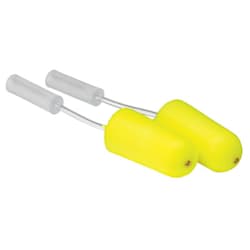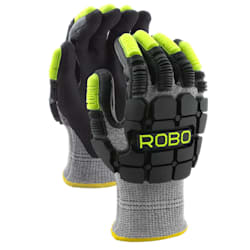Choosing the Right PPE
What is PPE?
What is PPE and Why is it Important?
PPE is likely an acronym you’ve recently begun to hear more frequently. There is a lot more to PPE than just face masks. Below, we explain the answers to some of the most frequently asked questions like:
- What is PPE?
- What does PPE stand for?
- Why is PPE important?
What is PPE? What Does PPE Stand For?
What is PPE? PPE is equipment that is worn to minimize exposure to hazards that can cause workplace injuries and illnesses. Examples of hazards include chemical, radiological, physical, electrical, and mechanical threats.
What does PPE stand for? PPE stands for personal protective equipment and may include items such as gloves, safety glasses and shoes, earplugs or muffs, hard hats, respirators, or coveralls, vests, and full body suits.
Learn more about our top PPE categories:
Work Gloves | Disposable Gloves | COVID-19 Reopening Supplies | Protective Clothing | Respirators | Hearing Protection | Safety Eyewear | Fall Protection | View All
Industries that commonly need PPE:
Automotive | Chemical Manufacturing | Construction | Food Processing | Glass Fabrication | Oil & Gas | Pharmaceuticals | Steel & Metal | Energy and Utilities | Forestry & Logging | View All
Work Gloves
Work gloves or safety gloves are made to keep you safe from hazards like chemical burns, cuts, abrasion, contact with bio-hazards, and more. The best gloves are comfortable as well as highly rated for safety.
Disposable Gloves
Disposable gloves help prevent cross-contamination in the workplace and can help protect hands from minor chemical hazards. They often offer more flexibility and dexterity than thicker work gloves.
Protective Clothing
The term protective clothing can apply to a vast array of PPE. Some garments, like disposable protective clothing, protect products from contaminants while others protect employees from dangerous hazards.
Respirators
Inhaling harmful gases or particulates can lead to injury for workers exposed to these hazards. Respirators can help protect employees. Stauffer can assess the protection needs of your facility and provide you with all necessary equipment, from disposable respirators to fully Self-Contained Breathing Apparatuses.
Hearing Protection
Damage to the human ear can begin at 85 decibels. Employees exposed to excessive noise levels must use hearing protection PPE such as earmuffs and earplugs.
Safety Eyewear
Eye and face injuries are some of the most common workplace injuries. Such a vulnerable part of the body needs protection across a vast array of industries. From pharmaceuticals to welding, safety eyewear is available in a multitude of styles and varieties for all your associates and applications.
Fall Protection
A fall hazard is any hazard in the workspace that could cause an accidental loss of balance or control, resulting in a fall. Stauffer partners with top suppliers to obtain expert-level knowledge on fall protection systems.
What is PPE's Proper Use?
The Occupational Safety and Health Administration, or OSHA, provides standards on personal protective equipment for various industries and hazards. General examples for PPE use include using safety eyewear wherever an employee may be encountering airborne debris. If there are falling object hazards, such as on a construction site, hard hats are required. The types of protective clothing you may need – hand protection, body protection, foot protection, or face protection are all dependent on the hazards you face in your specific workplace.
What is the Right PPE for You?
Every work site has different hazards which require different types of personal protective equipment. In order for your PPE to properly protect you, it needs to be the proper equipment for the situation. For example, if you work somewhere with sharp edges, knives, or other cut hazards, cut-resistant gloves would be required. Many types of personal protective equipment are required by OSHA to conform to standards laid out by the American National Standards Institute (ANSI). Cut-resistant gloves fall under these ANSI ratings. ANSI Cut Resistance Standards place cut-resistant gloves on a scale of A1 – A9 based on the compilation of data from a cut resistance test (see ANSI Cut Ratings Guide).
Let Us Help!
Most sellers or manufacturers of safety equipment will generally inform you of what standards their product is complying with. However, this may not always be enough. Just because a product is rated to withstand heat doesn’t mean it can handle the heat or flame hazards of your worksite. Product specialists at Stauffer Glove & Safety can help you determine what types of materials and products your safety program needs, what safety standards these products should meet, and how to use them correctly. For more info, feel free to check out our Safety Knowledge Center.
Instill a Culture of Safety
You've developed your safety program - now what? Selecting and purchasing the right personal protective equipment for your specific hazards is only one piece of the puzzle when it comes to safety. You also have to ensure personnel are trained to properly use the equipment, and most importantly, actually wear it.
This is why it is vital to establish a culture of safety in your workplace. If a piece of PPE is not worn or used properly, it does not provide the necessary protection. Employees should be trained to frequently inspect their PPE, report any damage or dysfunction, and request replacements when appropriate. Supervisors and safety managers must track and maintain continued training and PPE usage. Involve employees in any sort of safety training. Hold periodic safety meetings to maintain the culture of safety in the workplace. PPE is made to be the last line of defense. The first step is ensuring employees are working and behaving in a safe manner.
Finally, make sure you are consistently inspecting and maintaining your safety equipment. Like anything, PPE wears out over time and use. Worn or damaged PPE will not protect you properly.

COVID-19 Supplies
COVID-19 supplies: cleaning and janitorial products, hand protection, face coverings and more.

Cleaning & Disinfecting
The CDC has issued general cleaning and disinfection guidelines for all Americans.








